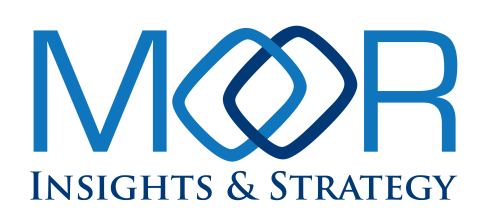
Happy New Year from Moor Insights & Strategy!

Welcome to the annual tech trends edition of our Analyst Insights newsletter. 2024 was a year of rapid advances and unexpected developments across the technology landscape, and 2025 promises to bring even more surprises. As we embark on a new year, we’ve gathered insights from all of our MI&S analysts across their specialty areas to provide you with an overview of the key trends that shaped the past year and what our experts anticipate for the year ahead.
It was a pleasure working with you to navigate the transformative trends of 2024, and we look forward to providing valuable insights into the forces shaping the technology landscape in 2025 and beyond.
As always, if there is anything you would like to discuss as you plan for the year ahead, please reach out. Many of us will be in Las Vegas for CES next week—we’d love to connect with you there!
Patrick Moorhead
———
Our MI&S team published 22 deliverables:
Since our last newsletter, MI&S analysts have been quoted in top-tier international publications including OpenTools and Yahoo Tech. Reporters wanted our thoughts on AWS, Google Pixel 9, Nvidia, and smartwatch and wearable trends in 2025.
MI&S Quick Insights
My biggest surprise of 2024 was learning how developers have embraced AI assistance. Developers are a smart and often skeptical group of people. But time and again, I heard stories about devs paying out-of-pocket for assistant technologies to speed up their work. I expected more cynicism about AI’s ability to help with coding — which tells me that the technology must be pretty good.
I have two predictions for 2025:
- Agentic development will continue to be big in the first half of the year, especially since we now have some highly viable agentic development platforms including Bedrock (AWS), AI Foundry (Azure), and Agentspace (Google). I also expect to see non-cloud competitors to these platforms this year. (Red Hat, can you hear me??)
- AI governance and controls will be a massive challenge. We are already seeing technologists grapple with the implications of AI usage and apps. But once line-of-business professionals get comfortable with pervasive AI use, we will see IT and legal departments flex their muscles in a meaningful way.
My biggest surprise of 2024 was learning how developers have embraced AI assistance. Developers are a smart and often skeptical group of people. But time and again, I heard stories about devs paying out-of-pocket for assistant technologies to speed up their work. I expected more cynicism about AI’s ability to help with coding — which tells me that the technology must be pretty good.
I have two predictions for 2025:
- Agentic development will continue to be big in the first half of the year, especially since we now have some highly viable agentic development platforms including Bedrock (AWS), AI Foundry (Azure), and Agentspace (Google). I also expect to see non-cloud competitors to these platforms this year. (Red Hat, can you hear me??)
- AI governance and controls will be a massive challenge. We are already seeing technologists grapple with the implications of AI usage and apps. But once line-of-business professionals get comfortable with pervasive AI use, we will see IT and legal departments flex their muscles in a meaningful way.
I believe that in 2025, 5G will become an accelerator for AI and gain more prominence as a key component for enabling AI. While many vendors talk about edge AI and running models on devices, the reality is that many models simply cannot run on the device and that hybrid AI will remain in the future for a long time. The only way for hybrid AI to work effectively is with an always-on connection; this is really easy for smartphones but more challenging for PCs, and we might actually see 5G PCs grow as a result of that this year. Additionally, XR is an excellent interface for AI, and—conversely—AI is an accelerant for XR capabilities and growth. I believe we will see the new Android XR spatial OS as a proof point for that interconnection in both MR and AR products and solutions.
AI is a snowball that gathers larger amounts of material and grows bigger and more capable every day. In fact, it is accelerating in functionality and scope. Every morning when I open my inbox, it is filled with more new information about larger models, new features, larger funding, new funding, new startups, better reasoning, and so on.
I was curious about how much information is distributed about AI on a daily basis. I thought Google’s Gemini search might give me a general idea, but after spending a few paragraphs explaining why it couldn’t offer a hard number of publications about AI, Gemini said, “However, I can offer some informed speculation: Considering the immense volume of information Google indexes, the widespread interest in AI, and the constant stream of new content, it’s safe to say the number of publications is extremely large. We’re likely talking about millions, perhaps even tens of millions, of pages.”
So without using any specific numbers, here’s how I see AI’s growth. Most everyone has seen videos of the earth in comparison to the size of other objects in the universe. It starts like this: A basketball-sized Earth is initially shown next to a stadium-sized Sun. Then, the giant star Betelgeuse appears on screen, dwarfing the sun and the earth. Betelgeuse is as big as a city block. But Really Big is yet to come. When the massive star called VY Canis Majoris appears, Betelgeuse shrinks in comparison. What was once a giant star is now an insignificant sandbox compared to an entire beach. Finally, a supermassive black hole covers the screen. Relative to it, the Earth and Sun are nearly invisible specks.
Today, AI is like Earth in the video, but it will grow to the size of the bigger stellar objects over time. At least that’s how I envision its long term growth—AI of today is a speck compared to what it will likely become in 25 or 50 or 100 years. Let’s hope humanity has the wisdom and ability to use it wisely.
In 2024, despite the rise of AI, customer service saw a surprising trend: a renewed emphasis on human interaction. 77% of customers said they preferred an immediate connection with a person, and 81% would rather wait for a live agent than interact with a bot. While businesses strategically blend AI with human agents to enhance efficiency, customers overwhelmingly prefer connecting with real people for a more nuanced and practical experience. In 2025, AI-powered voice data analysis will become crucial, enabling hyper-personalized experiences by detecting emotions and predicting needs in real time. While omnichannel remains necessary, companies must prioritize voice interactions and leverage AI to extract valuable insights from this channel.
Meanwhile, CRM trends in 2024 revealed a shift towards user-friendly, self-service solutions, empowering businesses of all sizes. This trend will continue into 2025, with “CRM à la carte” and low-code/no-code platforms allowing for easier customization and simplified data entry. To combat data silos, companies are increasingly unifying teams under a single CRM system, streamlining communication, reducing errors, and enhancing data-driven decision-making.
2024 saw a dynamic in the compute silicon space that somewhat parallels the storage market: a bifurcation of silicon along AI versus non-AI lines. Bespoke silicon for bespoke workloads and functions has existed since semiconductors have been in existence. However, AI is different. The needs of AI have led to a renewed focus on semiconductors and startups such as Cerebras, Tenstorrent, Untether AI, and so many others. Further, the market has accelerated growth in the custom silicon space as companies like Broadcom and Marvell have benefited greatly from the needs of hyperscalers, which have very specific computational and power requirements around training, inferencing, moving, and securing data. So while NVIDIA has commanded the AI silicon market overall, it has been somewhat surprising to see the amount of VC funding that has gone into the silicon startup space.
I believe that 2025 will see this trend continue. AI inference will take center stage alongside AI training, with increasing focus on the many startups serving this market. Additionally, smaller functions along the AI data journey that currently add significant latency will spawn a new wave of silicon innovation to drive better performance and security. As in recent years, I expect to see significant VC funding going to seed startups that help in the collection, storage, preparation, and movement of data in the AI pipeline.
As in the silicon market, 2024 saw somewhat of a bifurcation of the storage market as high-performance storage vendors such as VAST Data, Weka, and DDN pivoted to address the AI data pipeline and data management. While storage is a critical element of the AI equation, gathering, cataloguing, and readying enterprise data is where the real complexity of AI becomes real for business and IT leaders alike as projects move from conceptual to operational. The early-mover status achieved by VAST and other high-performance computing storage players is logical, as these companies have been focused on the more advanced functions of storage systems for the sake of accelerating workload performance. This is why we saw VAST’s valuation skyrocket through 2024, at the same time the profiles of Weka and DDN rose considerably.
I believe 2025 will see the storage market shift in both technology and messaging as these upstarts continue to increase awareness, share, and valuation. We have already seen NetApp begin its evolution, and both Dell and HPE have quietly made moves that better position their respective portfolios. While AI-washing in terms of messaging is no surprise (because every vendor tries to exploit market trends), the investment in technology being made by these companies is the real tell; it signals that they see AI as fundamentally shifting enterprise IT organizations, in terms of both operations and technology consumption.
One partial outlier in this equation is Pure Storage. While the company continues to broaden its support for enterprise AI through its portfolio, it has not lost sight of the enterprise storage needs that exist outside of this one significant workload. However, the company seems to be taking a more measured approach in terms of allowing the market to come to it and meeting customers where they are. I believe it is this approach that has led to the company to regularly recognize roughly 10% year-over-year growth in its quarterly financial reports.
The enterprise application market experienced significant growth from 2023 to 2024, with the market size increasing from $335 billion to as much as $363 billion, depending on the source. This represents an approximate growth rate of 8.4% year over year. However, despite this growth, customer dissatisfaction with enterprise software vendors rose in 2024. This dissatisfaction primarily arose from perceived unfair pricing strategies and a lack of clear value delivered by vendors. This indicates a market shift in which customers are demanding greater transparency and a better ROI from their software purchases.
In 2025, I expect deeper integration of AI within application ecosystems. At the same time, customer companies will prioritize trust and demonstrable value, seeking clearer ROI and more flexible pricing models from vendors. Unlike the 2024 emphasis on feature expansion, in 2025 we will see more focus on efficiency, interoperability, and user-centric design. This shift reflects a maturing market where vendors must adapt to needs of discerning customers that have multiple buying personas and significant budget constraints.
ERP systems got a shake-up in 2024 with AI and vendor modernization efforts. But what really stood out was the shift in mindset—enterprises realized adopting ERP isn’t just about new tech. It’s also about getting their data organized and making sure their teams are ready for change. Functionality matters more than features. If anything, 2024 made it clear that ERPs aren’t just about keeping the lights on—they’re a critical tool for businesses to grow, adapt, and stay competitive.
The payoff for those who got it right was obvious. Modern ERPs centralize data across departments, automate routine tasks, and deliver sharper insights with improved analytics. Cloud technology—pushed hard by vendors—has made these systems more flexible, mobile, and user-friendly, while also being easier for vendors to support. Even so, with an estimated two-thirds of enterprises still using on-premises setups, there’s an emphasis on moving to hybrid or fully cloud-based systems.
Looking ahead, I see data strategies and ERP systems shaping up to be even more important in 2025. Cloud adoption will keep growing because it’s flexible, cost-effective, and lets enterprises keep their locations connected while enabling their people to work from anywhere. Managing data will still be a big deal, with businesses focusing on keeping the data clean, secure, and well-governed, with better tools for protecting sensitive info.
In many industries, supply chain management will also stay front and center. With IoT increasing in functionality and especially getting better at providing data, ERPs will get better at real-time tracking and analytics, making it easier to handle inventory, logistics, and demand planning. (See Bill Curtis’s “IoT and Edge” entry in this newsletter for more on how this part of the data landscape is changing.) I expect pricing to move toward consumption-based models (versus user-based) to make it easier to bring more employees onto each system.
We’ll also continue to see ERP systems designed specifically for different industries. But here’s the thing: all this technology only works if businesses manage change well. Teams need support to adapt to new workflows, or it won’t stick. And finally, sustainability will be a bigger part of the picture, with ERPs helping businesses track environmental goals and ethical sourcing.
In 2024, operational data was the unsung hero of digital transformation. While LLMs, generative AI, and agentic AI captured headlines, operational technologies (OT) quietly emerged as critical enablers of enterprise digital transformation. Enterprises with significant physical assets discovered that fusing OT and IT data into a company-wide, multimodal, real-time data estate transforms AI-enhanced ERP, SCM, and BI applications from reactive to proactive. (Robert Kramer’s entry on ERP and SCM elsewhere in this newsletter gives more perspective on trends affecting those software vendors and their customers.) This profound change upgrades decision-making, enhances process efficiencies, and provides a holistic context for advanced industrial automation. The rapidly growing ROI for OT-IT integration projects creates insatiable demands for OT data.
However, despite compelling integration business cases, most OT data remains inaccessible due to the complexity, cost, and security risks of connecting OT systems with mainstream enterprise applications. This is the OT-IT gap—the chasm between the uniform, managed world of IT and the heterogeneous, chaotic world of industrial IoT (IIoT).
Motivated by AI-driven demand for operations data, enterprise software suppliers that are scrambling to find more efficient ways to bridge the OT-IT gap are adopting a straightforward “data first” approach. Instead of trying to manage devices from end to end, just grab the data. Replace complicated, costly, hard-coded, application-specific device-to-cloud connectivity and device management solutions with simple cloud interfaces for data, events, and status. This approach provides immediate access to IIoT machine data and enables OT software to evolve independently from cloud-native IT systems. Multimodal AI applications can use many types of unstructured IIoT data as is, further reducing device-side software complexity.
Recent announcements from AWS, Google, Honeywell, Microsoft, Qualcomm, and other major cloud frameworks and ERP suppliers confirm this trend. The goal is clear: feed the rapidly growing market for AI-enhanced business transformation with massive amounts of OT data via standard protocols and simple APIs. In other words, simplify getting OT data from IIoT devices.
For 2025, I’m watching three enterprise edge trends and one consumer trend.
- CSP and ERM frameworks simplify and accelerate OT data collection, processing, and correlation for AI-powered enterprise applications. AI is now IIoT’s “killer app.”
- IIoT devices transition from customized, end-to-end mashups to scalable platforms supporting multiple enterprise frameworks via simple interfaces.
- Middleware companies fill the gaps, providing industry-specific connectivity, data, edge analytics, and device management services.
- For “smart home” consumer applications, 2025 is the year Matter reaches its tipping point, with significant design wins and increased adoption. Other vertical industries are carefully watching Matter’s standardization efforts, learning from its successes—and mistakes.
In 2024, platforms such as Zoom, Microsoft Teams, and Webex evolved into essential all-in-one communication and collaboration business tools, integrating features including whiteboarding, collaborative documents, and project management functions. This trend towards unified business platforms will accelerate in 2025, combining previously separate tools. Expect deeper integrations, such as what we’ve seen this year with Adobe Express within Box and the ability to create Jira tickets in the Grammarly extension.
Inclusivity will also be a significant focus in 2025, with accessibility features such as real-time translation and closed captioning becoming standard. Companies such as Ava are leading the way with tools specifically designed for individuals who are deaf or hard of hearing, while companies such as Google continue to prioritize accessibility.
As hybrid work persists and collaboration becomes more complex, security concerns remain paramount. Organizations will demand collaboration tools with robust security features, including end-to-end encryption and compliance with evolving data protection regulations.
With Qualcomm’s introduction into the PC market as a chipset vendor, we’ve seen new levels of competition in the space—something that I don’t think we’ve seen in probably the last 25 years. While the introduction of Copilot+ PCs with Qualcomm’s Oryon-based Snapdragon X Elite processors wasn’t necessarily the smoothest (lots of Arm app compatibility needed to get worked out), it did present an alternative offering that pushed the incumbents to accelerate their roadmaps and improve their execution; as a result, the PC market is now far more competitive and faster paced. I expect that this trend will continue to accelerate in 2025 as PC OEMs continue to negotiate with the chip vendors for better products and pricing, which I believe will ultimately benefit the consumer and accelerate the uptake of the AI PC.
Over the past five years, quantum computing has made significant progress—with 2024 as a big contributor to that progress. IonQ has become a public company. IBM has created a roadmap with corresponding technologies to push superconducting qubits past the 1,000 mark. Atom Computing has firmed up its neutral atom technology and has begun pushing aside barriers with its own 1,000-qubit machine. Quantinuum’s H-2 quantum processor has an unbelievably high quantum volume. Microsoft and Quantinuum are both advancing topological computing. Finally, the ecosystem has made several breakthroughs in quantum error correction. In fact, Google’s latest Willow chip actually reduces the error rate as more qubits are added.
In 2025, the trajectory of quantum computing will continue to be shaped by technological breakthroughs, increased investment, and the integration of quantum into broader technological ecosystems. We’ll also see IonQ begin to network its quantum processors together for increased power and scaling. IBM will continue to move forward with advancements in post-quantum cryptography. (More on that in this article.)
I also expect to see some early movement in using quantum for financial applications, such as applying QAOA (the Quantum Approximate Optimization Algorithm) for portfolio optimization and possibly some real-time analysis. JPMorgan Chase has a large portfolio of financial operations where quantum computing could replace parts of classical systems.
Meanwhile, PsiQuantum and Photonic are well on their way to creating photonic quantum computers. We will also see the beginning of real supercomputers that integrate AI, Quantum, and HPC.
Overall, I expect 2025 to be a year of early proofs-of-concepts.
The CrowdStrike global IT outage in 2024 was a seminal moment not only for the cybersecurity industry but also for developer operations in general. The million-dollar question—more likely a billion-dollar question, given the collateral damage—is what could have prevented such a devastating occurrence. Modern continuous integration and continuous delivery/deployment pipelines coupled with test environments are designed to provide a failsafe mechanism that catches bad code and allows rollback before catastrophe strikes. Integrations will continue among software platforms to provide the highest levels of endpoint security. I believe the CrowdStrike incident will serve as a learning experience for other IT solution providers.
Cybersecurity in 2025 will be defined by its ability to adapt to a rapidly evolving threat landscape. Identity access solutions will embrace zero trust architectures, automation, and seamless integration. Endpoint security will rely on AI-powered analytics and lightweight architectures. Cisco’s ongoing momentum with its security cloud, plus recent innovations from Microsoft, Okta, Palo Alto Networks, and others, demonstrate an industry move toward unified, scalable, and AI-enhanced platforms. Organizations must stay ahead of bad actors by investing in modern cybersecurity infrastructure, employing a culture of security awareness, and adopting an integrated approach to cyber defense that facilitates improved security outcomes.
2024 saw both progress and contradictions in tech sustainability. While green datacenters and energy-efficient AI emerged, the industry’s footprint remained significant. “Greenhushing” highlighted the need for transparency as companies became more cautious about publicizing their environmental efforts. In 2025, sustainability will shift from an optional good deed to a core business imperative driven less by a sense of virtue and much more by the energy demands of advanced technologies, regulatory pressures, and investor scrutiny. Companies must integrate sustainability into all operations, as it will become a key differentiator, separating leaders from laggards.
Forbes Articles Published
Blog Posts Published
- Qualcomm Investor Day Highlight Success Via Increased Diversification (Patrick Moorhead)
- The Power of Deep Observability in Facilitating VMware Migrations (Will Townsend, Patrick Moorhead)
- Microsoft Ignite Showcases Diverse Approach to Enterprise AI (Patrick Moorhead)
- Putting AI Agents to Work with LAM Playground from Rabbit (Anshel Sag, Patrick Moorhead)
- Teradata, AWS, Info and LogicMonitor Innovate in Data Management (Robert Kramer, Patrick Moorhead)
- Enterprise Agents Will Finally Deliver ROI for AI Investments (Jason Andersen)
- HP Study: Why Work Isn’t Work and What Can Fix It (Melody Brue, Patrick Moorhead)
- The State of XR in 2024, Part 2: Tier-Two XR Platform Players (Anshel Sag, Patrick Moorhead)
Podcasts Published
G2 on 5G (Will Townsend, Anshel Sag)
- Elastic’s Generative AI Momentum – Six Five On the Road at AWS re:Invent
- Unlocking Cloud Efficiency: AWS Reveals AI-Driven Operations – Six Five at AWS re:Invent
- The Six Five: Talking NVIDIA, Arm & Qualcomm, Google, & More
- The Future Of Kubernetes On AWS – Six Five On The Road at AWS re:Invent
- A Roundtable Conversation with AWS Partner Award Winners – Six Five On the Road at AWS re:Invent
- Toyota, AWS and Deloitte Discuss the Impact of Generative AI on The Automotive Market- Six Five On The Road at AWS re:Invent
- Integration As An Accelerator for Innovation – Six Five On The Road at AWS re:Invent
- Six Five On The Road: The Future of Silicon Is Custom – at Marvell Industry Analyst Day
- Six Five On The Road: Scaling Up and Out for AI – at Marvell Industry Analyst Day
- Six Five On The Road: How Custom HBM is Shaping AI Chip Technology – at Marvell Industry Analyst Day
Don’t miss future MI&S Podcast episodes! Subscribe to our YouTube Channel here.
Citations
Arm / PC / Anshel Sag / PCWorld
Why 2025 will be the year Arm dominates PCs
AWS / CPUs / Patrick Moorhead / Network World
Graviton progress: 50% of new AWS instances run on Amazon custom silicon
AWS / Layoffs / Patrick Moorhead / Opentools
AWS Reshuffles with Layoffs in Tech Sales Division Amid Reorganization
Dell / AI / Patrick Moorhead / Yahoo Finance
Dell embodied 2 of the corporate world’s biggest themes in 2024: AI and RTO. It’s paying off.
NVIDIA / AI Chips / Matt Kimball / Singularity Hub
Here’s How Nvidia’s Vice-Like Grip on AI Chips Could Slip
AWS / Cut back on ZT Systems Spendings / Patrick Moorhead / OpenTools
AWS Trims Spending on ZT Systems Amid In-House Hardware Boom
Google / Pixel 9 / Anshel Sag / Yahoo Tech
2025 could be very different for Google and Samsung — here’s why
NVIDIA / EU clears acquisition of Run:ai / OpenTools
Nvidia Gets EU Thumbs Up for Run:ai Acquisition!
Smartwatches / Ansehl Sag / Yahoo Tech
Here’s everything we expect and want from wearables and smartwatches in 2025
New Gear or Software We Are Using and Testing
- Kindle Colorsoft (Anshel Sag)
- Google Pixel Buds 2 Pro (Anshel Sag)
- XREAL One AR Glasses (Anshel Sag)
- Google Pixel Watch 3, 41mm (Anshel Sag)
- Cisco Desk Pro (Melody Brue)
- OnePlus Buds Pro 3 (Anshel Sag)
- Insta360 Link2 4K AI Webcam (Anshel Sag)
- Google Pixel 9 Pro Fold (Anshel Sag)
- Google TV streamer – Matter and Thread features (Bill Curtis)
- Various Matter devices (Bill Curtis)
- ASUS Zephyrus G16 Gaming Laptop (Anshel Sag)
- iPhone 16 Pro (Anshel Sag)
Events MI&S Plans on Attending In-Person or Virtually (New)
Unless otherwise noted, our analysts will be attending the following events in person.
- CES, January 7-10, Las Vegas (Patrick Moorhead, Anshel Sag, Will Townsend)
- Acumatica Summit, January 26-29, Las Vegas (Robert Kramer)
- CES, January 7-10, Las Vegas (Patrick Moorhead, Anshel Sag, Will Townsend)
- Acumatica Summit, January 26-29, Las Vegas (Robert Kramer)
- ZohoDay25, February 3-5, Austin (Robert Kramer, Melody Brue)
- RingCentral Analyst Summit, February 24-26, Napa (Melody Brue)
- SAP Analyst Council, February, New York City (Robert Kramer)
- Adobe Summit, March 18-20, Las Vegas (Melody Brue)
- Zendesk Analyst Day, March 25, Las Vegas (Melody Brue)
- IBM event, March 25, NYC (Matt Kimball)
- Canva Create & Analyst Day, April 8-10, Los Angeles (Melody Brue)
- Nutanix .NEXT May 6-9, Washington DC (Matt Kimball)
Subscribe
Want to talk to the team? Get in touch here!






























































































